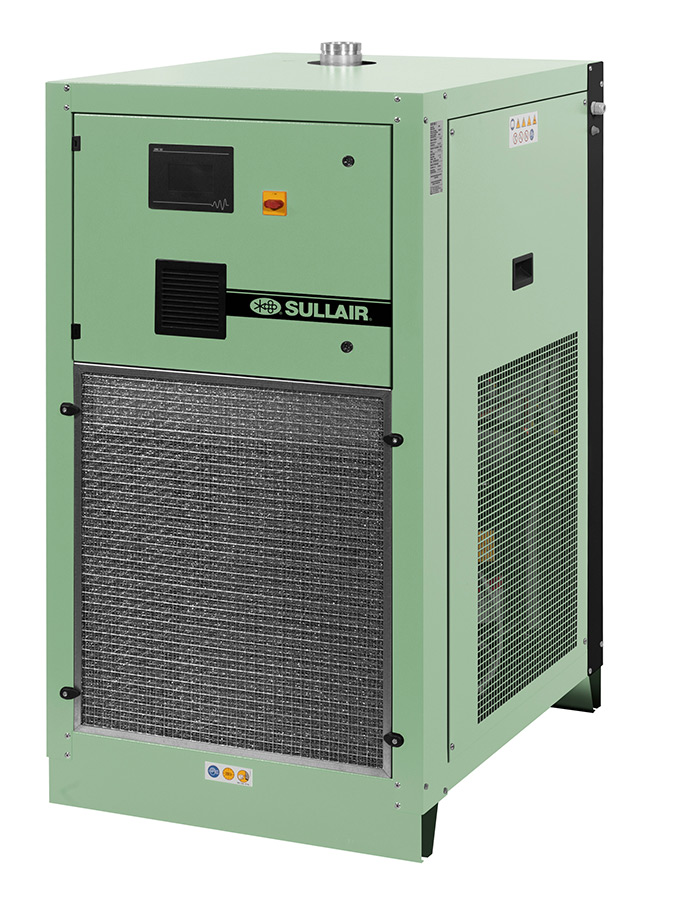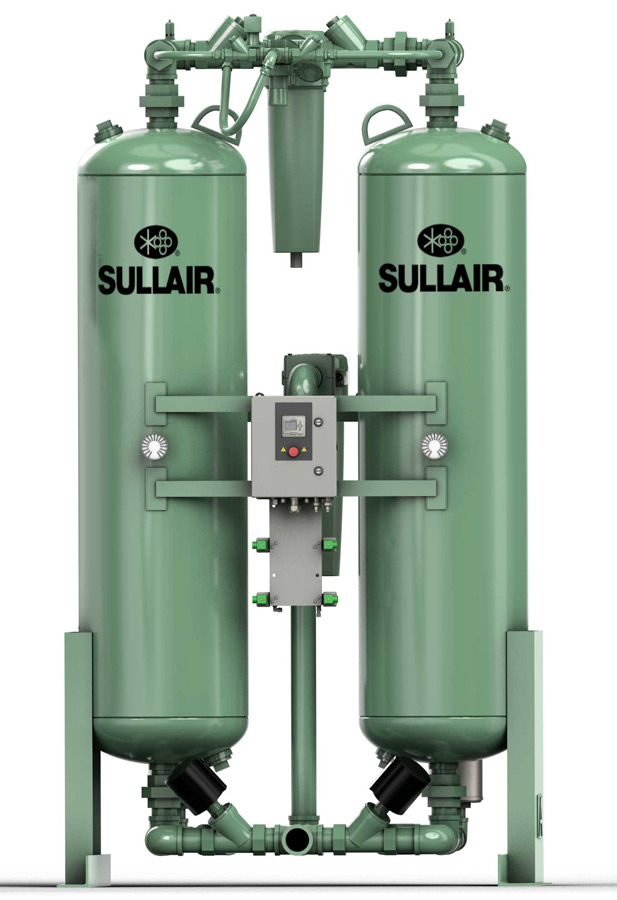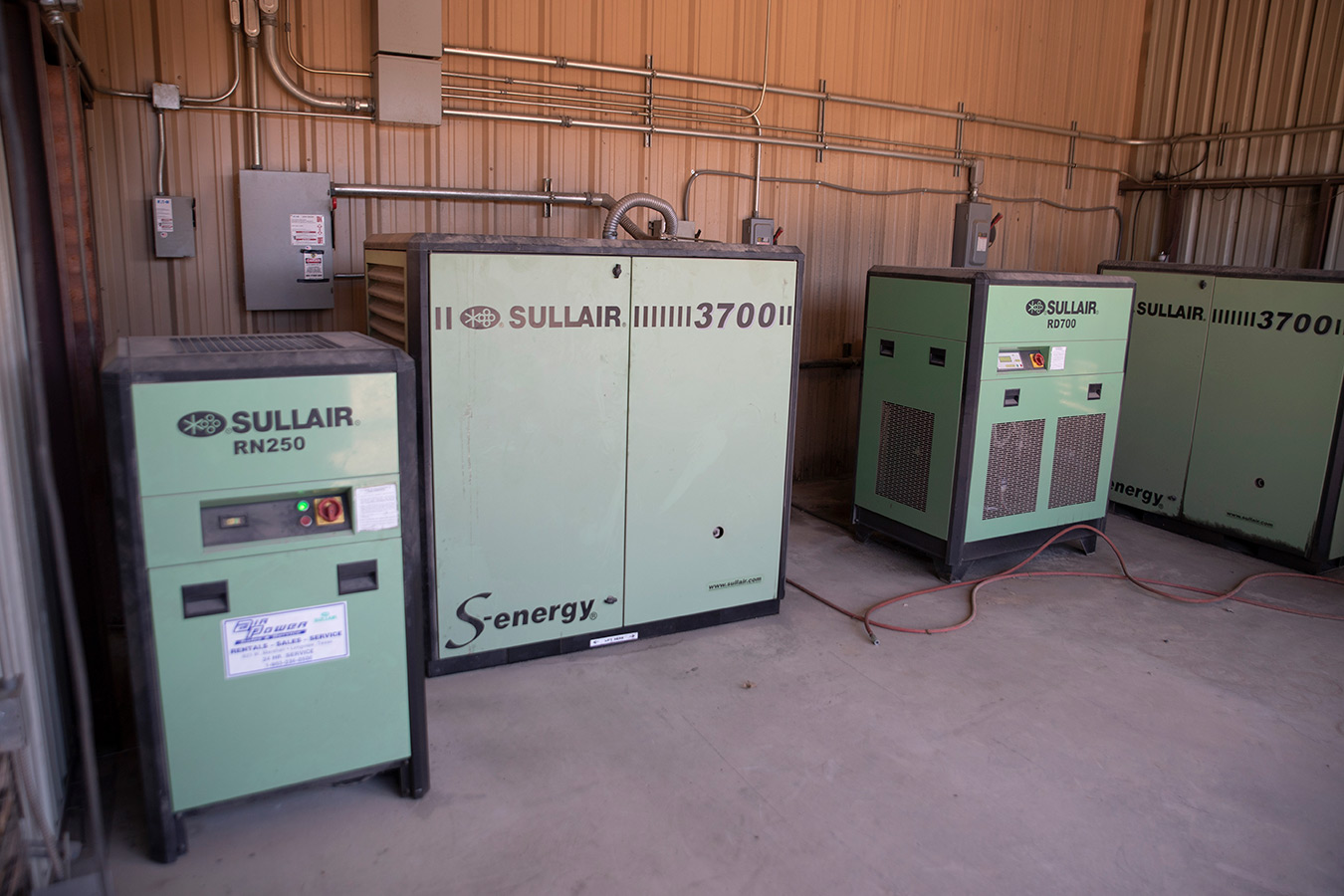
For an industrial compressed air system, removal of moisture from the compressed air stream is a vital task. Dry compressed air helps keep air-powered tools, equipment, and instruments running well. It can also help prolong the life of both tools and piping by reducing the rate of corrosion caused by excess moisture. And for industrial processes where the air stream makes contact with the final product, or in some cases even its packaging, it is critical that the compressed air be the proper quality, including the dew point of the air.
Drying compressed air incurs costs for the purchase and operation of equipment. The dryer and cleaner the air, the more expensive the compressed air becomes to create. To create dry compressed air efficiently, and therefore economically, you need to choose the right type of compressed air dryer and size it correctly for your application.
(The term “dry” when associated with compressed air is relative to the needs of the process. Compressed air that is considered clean and dry enough to operate machine tooling is not considered dry enough for a powder coating process.)
As their name implies, refrigerated dryers remove moisture from the compressed air stream mechanically by cooling it. Cool air can’t hold as much water vapor as warm air, so as the air cools excess water vapor condenses out as liquid water. This condensate must then be removed from the system.
Desiccant dryers remove moisture from the compressed air stream chemically by passing the air over a bed of desiccant. The desiccant adsorbs the water vapor, i.e. the water vapor clings to thousands of tiny pores in each bead of the desiccant.
Once the desiccant bed becomes saturated, either very low dew point compressed air or heated purge air is used to dry the desiccant. Desiccant dryers have drying beds arranged in pairs, so that while one desiccant bed is drying the air, the other desiccant bed is being dried, allowing for continuous drying of the compressed air stream.

Refrigerated dryers require lower capital investment then heated desiccant dryers and have relatively low operating and maintenance costs. This makes them an economical choice for a wide variety of industrial applications. However, they can’t meet the requirements for some moisture level requirements or site conditions.
The refrigerated drying process typically results in pressure dew points between 34 and 40°F (1 and 4°C), removing about 98% of the moisture from the compressed air stream. This meets ISO 8573.1 Class 4, 5 and 6 standards for humidity and liquid water.
Most industrial applications require Class 4, 5, and 6 air for water vapor levels. Some examples are:
However some applications require Class 1, 2 or 3 ultra-dry air, which refrigerated dryers simply can’t reach.
In temperatures at or below 32°F (0°C), the condensate created from the cooling process would freeze rather than drain, making refrigerated dryers unsuitable for sub-freezing conditions.

Desiccant air dryers can require a larger capital investment and have higher operating and maintenance costs than refrigerated dryers, so refrigerated dryers are usually preferred when they can do the job. However, under some moisture level requirements or due to site conditions or process requirements, desiccant dryers can get the job done when refrigerated dryers can’t.
The desiccant drying process allows desiccant dryers to reach pressure dew points of -40°F (-40°C); some designs can be configured to reach -100°F (-73°C). This allows them to meet the requirements of ISO 8573.1 Class 2 and 3 standards for humidity and liquid water, with some designs meeting Class 1.
Example uses of Class 1, 2, and 3 air for water vapor levels are:
Desiccant dryers use a chemical process (desiccant adsorption) to reach pressure dew points below ambient temperatures. Moisture does not condense, preventing water from freezing in the dryer or the process air supply piping or equipment.

In some situations, only a small amount of the overall compressed air stream is used for ultra-dry air—for example, 10% of the air is used for a facility instrument air application. In these situations, drying the entire compressed air stream to Class 1, 2 or 3 is not an efficient solution, as costs are driven up to dry most of the air far beyond what is needed.
A more economical solution in these cases is to use a refrigerated/desiccant hybrid system, placing desiccant dryers just before the points-of-use requiring lower dew point air. Capital, operating and maintenance costs are kept as low as possible while still drying the air for each part of the system to the pressure dew point needed.
For dryers of all types, the rated drying capacity is based on standard conditions given with the dryer specifications. In the United States, these are generally:
If your operating conditions are outside of the dryer’s standard, the dryer’s actual capacity in those conditions will vary from its rated capacity.
All types of compressed air dryers are significantly affected by inlet air temperature coming from the air compressor. The higher the inlet air temperature, the more water vapor the air can hold, so the more moisture the dryer needs to remove, leading to a reduced drying capacity.
A lower inlet air temperature reduces the amount of water vapor the air can hold, leading to an effective increase in drying capacity.
All compressed air dryers are also affected by the inlet air pressure. The lower the air pressure, the higher the velocity of the air moving through the air dryer. This results in less contact time with either the heat exchanger (in a refrigerated air dryer) or the desiccant beads (in a desiccant dryer). The lowered contact time results in less efficient drying of the compressed air, thus reducing drying capacity.
A higher inlet air pressure decreases air velocity. This results in longer contact time with the drying media, giving the dryer a greater drying capacity.
While all compressed air dryers can be affected by high ambient temperature because it raises the inlet air temperature (see above), refrigerated dryers are also affected more directly. As the ambient air temperature increases, the refrigerated dryer dissipates heat less effectively, which makes the cooling process less efficient, leading to a reduced dryer capacity.
In a cooler environment, the dryer can dissipate heat more effectively, making the cooling process more efficient and increasing the dryer capacity.
Dryer manufacturers provide correction factors for non-standard conditions, usually with the dryer literature. Apply these correction factors to a dryer’s rated capacity to get its actual capacity under your operating conditions. If your operating conditions vary, use the correction factors for the worst set of conditions your system will face.

You should never undersize your compressed air dryers. Doing so will leave more water vapor in the compressed air stream downstream from the dryer. Therefore, you may not be meeting the level of dryness (the pressure dew point) required for your process, application, or equipment, which could lead to equipment damage or failure or even an unusable end product.
One issue with oversizing your dryers are the increased capital and operating costs. Another is increased maintenance costs and shorter equipment life, especially with refrigerated dryers. Dryers, like all compressed air equipment, are designed to be operated at full load capacity. The lighter the load the more stress that is put on the dryer’s controls. However, the marginal cost of “sizing up”, even for a desiccant dryer, is relatively small compared to the ultimate potential costs of undersizing.
When selecting dryers for your compressed air system, you want to dry your compressed air stream as much as needed, but no more. While the above overview of dryer types and sizing can help you understand the factors involved in making your selection, you should always consult an expert to help you configure your system. Their years of experience in configuring compressed air systems across a wide variety of applications can help ensure that you get the most economical drying solution that meets the needs of your application and operating conditions.
Use the checkboxes to select the types of cookies you want to accept, then press the “Save Settings” button. View our Privacy Policy.